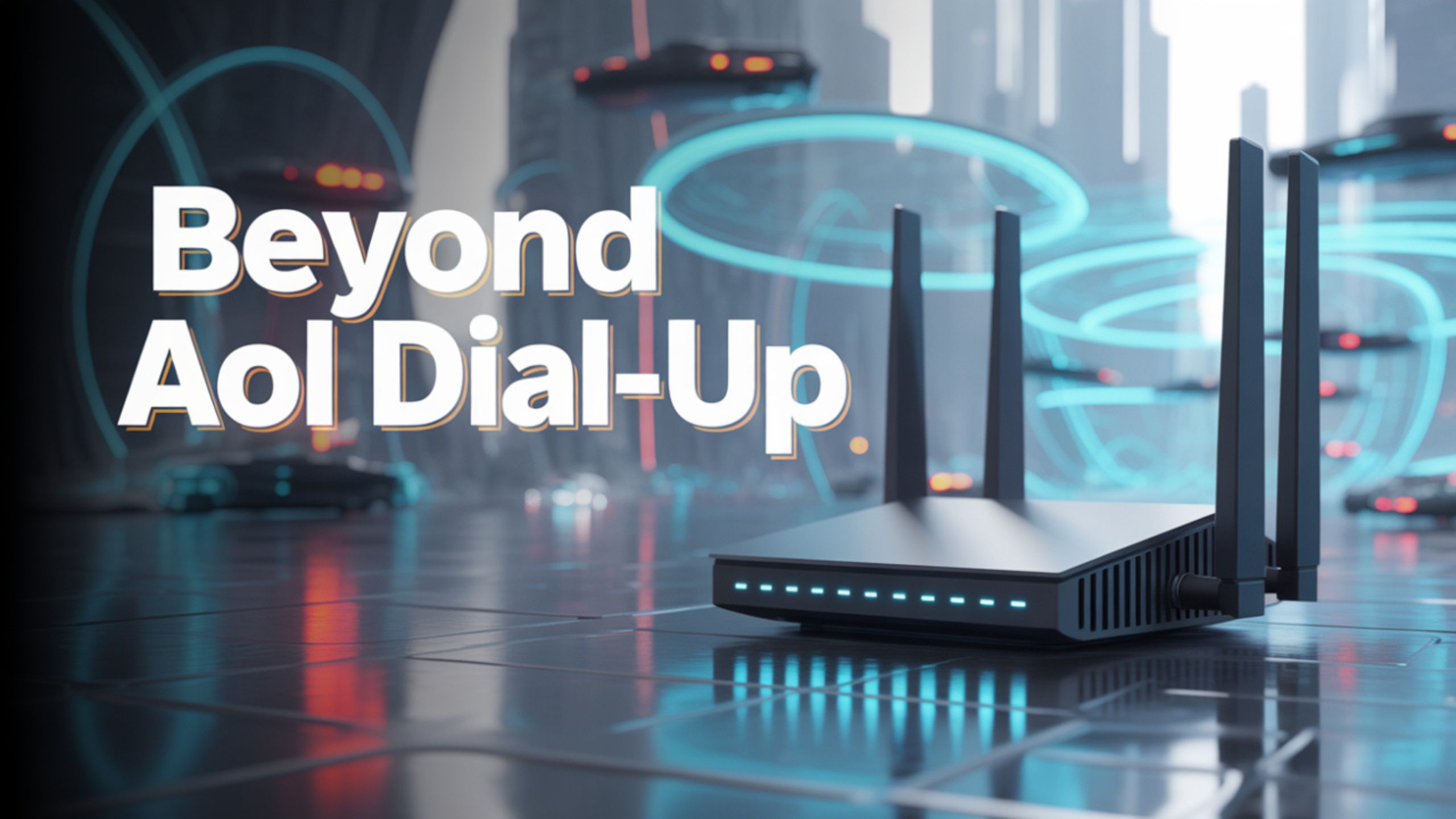On September 30, 2025, AOL will officially shut down its dial-up internet service, concluding over three decades of slow, noisy, modem-based connections. Once the dominant way millions accessed the web, dial-up operated at painfully slow speeds—around 0.056 Mbps at its peak—and has now been overtaken by broadband technologies offering hundreds or even thousands of Mbps. This change is more than just a technical upgrade—it represents a complete transformation in how we connect, communicate, and consume information. Below, we explore why dial-up is retiring, the rise of its modern replacements, and how to choose the best internet technology for your needs.
The Decline of Dial-Up: Why the World Moved On
Dial-up Internet uses traditional telephone lines to connect users to the web. It required a physical modem translating digital signals into tones transmitted over voice lines. While revolutionary in the 1990s, it came with severe limitations:
- Extremely slow speeds – topping out at just 56 Kbps.
- Single-line usage – without extra hardware, you couldn’t use the phone and Internet simultaneously.
- Frequent disconnections – unstable connections were the norm.
- High latency – making modern streaming, gaming, and video conferencing impossible.
With the advent of always-on broadband connections in the early 2000s, users quickly abandoned dial-up. By the 2020s, only a tiny fraction of rural and underserved communities still relied on it—mostly where broadband was unavailable.
Modern Alternatives to Dial-Up Internet
Today’s internet landscape offers a variety of faster, more reliable, and more affordable options. Here’s a detailed look at the leading technologies replacing dial-up.
1. DSL (Digital Subscriber Line)
Technology: It uses traditional copper telephone lines but operates on different frequencies, allowing phones and the Internet to work simultaneously.
Advantages:
- Always-on connection.
- More reliable than dial-up.
- Affordable plans.
Speed Range: Tens of Mbps up to 100+ Mbps in some areas.
Limitations:
- Speeds decline with distance from the telephone exchange.
- Not as fast as cable or fiber.
Best For: Areas with established telephone infrastructure but lacking cable or fiber.
2. Cable Internet
Technology: Delivers Internet over the same coaxial cables used for cable television.
Advantages:
- Fast and stable performance.
- Widely available in suburban and urban areas.
- Bundling options with TV and phone services.
Speed Range: Up to 800 Mbps, with some gigabit plans available.
Cost: Plans often start around $60/month for high-speed tiers.
Best For: Households that need high bandwidth for streaming, gaming, and work-from-home.
3. Fiber-Optic Internet (FTTH)
Technology: Transmits data as light signals through thin glass strands, providing ultra-fast and low-latency connectivity.
Advantages:
- Speeds in the hundreds of Mbps to several Gbps.
- Symmetrical upload and download speeds.
- Extremely low latency—ideal for gaming, cloud computing, and video conferencing.
Limitations:
- Still limited in availability—mainly in cities and select towns.
Best For: Users demanding top-tier performance for heavy internet use, large file transfers, and high-resolution streaming.
4. Fixed Wireless Internet (Including 5G Home Internet)
Technology: Connects homes to the Internet using radio signals from nearby cell towers—no need for wired lines.
Advantages:
- Quick to set up.
- No cable or phone lines required.
- Works well in rural or suburban areas with good tower coverage.
Popular Options:
- T-Mobile Home Internet: Up to ~180 Mbps for around $50/month.
- Verizon 5G Home: Up to ~300 Mbps in areas with strong 5G coverage.
Best For: Locations with strong cellular networks but limited wired broadband options.
5. Satellite Internet (Geostationary)
Technology: Relays signals between satellites in geostationary orbit and ground stations.
Advantages:
- Available virtually anywhere with a clear view of the sky.
- Lifeline for remote and rural areas without cable, fiber, or strong wireless signals.
Speed Range: 25–100 Mbps, but with higher latency (600+ ms).
Examples:
- Viasat
- HughesNet
Best For: Remote regions where wired and wireless Internet is unavailable.
6. Low Earth Orbit (LEO) Satellite Internet
Technology: It uses a network of satellites that is much closer to Earth than traditional geostationary satellites, resulting in lower latency and faster speeds.
Advantages:
- Speeds of 200–250 Mbps (and growing).
- Latency around 20–40 ms, similar to wired connections.
Examples:
- Starlink – Active in multiple countries and expanding rapidly. Currently operational in nearby Bangladesh, with India pending regulatory approval.
- Amazon Project Kuiper – Expected to launch by mid-2026, offering speeds up to 400 Mbps in remote parts of Australia and eventually worldwide.
Best For: Rural and underserved areas needing high-speed, low-latency Internet without traditional infrastructure.
Quick Technology Comparison Table

How to Choose the Best Option for You
- Check Local Availability – Not all internet technologies are accessible everywhere. Use ISP availability checkers for your area.
- Prioritize Speed and Reliability – Choose fiber or cable for consistent high performance if available.
- Consider Installation Time – Wireless and satellite services can often be deployed faster than wired lines.
- Balance Cost and Performance – Budget-friendly DSL may be sufficient for light users, while heavy streamers and gamers will benefit from fiber or high-speed cable.
- Future-Proof Your Connection – Select a service with the potential for upgrades as technology improves.
The Future Beyond Dial-Up
Dial-up’s retirement is symbolic—it signals the end of an era when connecting to the Internet was an event rather than a constant background utility. Today, connectivity is as essential as electricity, and modern solutions provide speeds hundreds of times faster with the reliability to match.
As technologies like fiber expansion, 5G rollout, and LEO satellite networks advance, we are moving toward a world where high-speed Internet is universally accessible, bridging the gap between urban and rural communities.
Ask Follow-up Question from this topic With Google Gemini: Best Modern Alternatives to AOL Dial-Up Internet in 2025

Selva Ganesh is a Computer Science Engineer, Android Developer, and Tech Enthusiast. As the Chief Editor of this blog, he brings over 10 years of experience in Android development and professional blogging. He has completed multiple courses under the Google News Initiative, enhancing his expertise in digital journalism and content accuracy. Selva also manages Android Infotech, a globally recognized platform known for its practical, solution-focused articles that help users resolve Android-related issues.




Leave a Reply